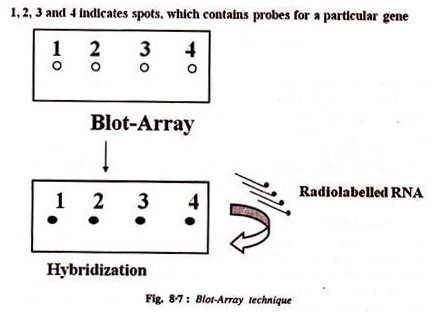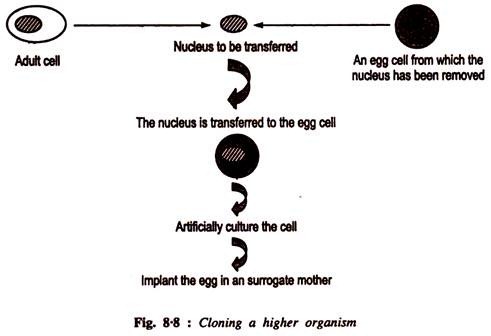Here we detail about the top three methods to study the function of genes.
The three functions are: (1) Transcriptomics, (2) Gene Knockout, and (3) Cloning an Organism.
1. Transcriptomics:
Study of the gene expression in the genome is called transcriptomics. We can study the expression of individual group of genes or all genes in the genome gene).
Expression of the genes can be studied by a technique called Northern Blotting. It is very similar to the earlier described technique called as Southern Blotting. In Northern blotting, the target is the total RNA (m-RNA, t-RNA, r-RNA), or only the m-RNA. In this method the RNA is isolated and separated in an agarose gel.
In the Gel and the buffer some amount of formaldehyde is added, because it helps the RNA to remain in linear form. Once the RNA is separated the RNA is transferred on a solid membrane support (nitrocellulose, nylon etc). Then the membrane is hybridized with the probe which is the gene of interest for which we want to study the expression.
The probes are usually radiolabeled and, after hybridization, the membrane is washed to remove the loosely bound or nonspecifically bound probe. Autoradiography is then done to see the signal of the radioactive probe. In this the intensity of the radioactive signal is directly proportional to the expression (amount of m-RNA of that particular
We use a modified technique very similar to Northern Blotting to study the expression of a group of genes. This technique is called Blott-Array. In this technique the group of genes whose expression we want to study is spotted on a Nylon membrane. Then the membrane is hybridized with the radiolabeled RNA.
After hybridization, the loosely bound RNA is removed by washing and the blotting membrane is exposed to autoradiography. In this the intensity in each spot (where the particular gene is spotted) is directly proportional to the expression of that particular gene (Fig. 8.7).
2. Gene Knockout:
This technique is used to study the function of the gene by making it nonfunctional. The principle behind this is simple. Under normal condition a particular gene is doing its function by the production of RNA from transcription and, finally the protein by translation. By inactivating the gene (gene knockout), we are able to switch-off the gene and the phenotype of the organism can be studied in the absence of the product made from that particular gene.
There are various ways to knockout a gene, by disrupting the gene in the genome, by deleting the whole or part of the gene, or by inserting an additional DNA in the gene, which act as an insulator in the transcription. These methods of Gene knockout are now becoming very powerful tools in the study of the genome and also the function of individual genes.
3. Cloning an Organism:
A clone means an exact replica of an individual which has the same genetic makeup as the source from where it has originated. In this modern age of Biotechnology, several strategies have been developed to clone a whole organism. We will describe here the most popular and successful method—nuclear transfer technique.
In this technique the egg cell is taken and the nucleus of the egg cell is removed with the help of an instrument called Micro Manipulator. Then the target cell or the nucleus, which we intend to clone, is fused with the enucleated egg cell (from where the nucleus has been removed earlier).
After fusion the egg cell is artificially induced to divide and the dividing egg cell is then implanted in the womb of a surrogate mother. This whole procedure is depicted in short in Fig. 8.8. Fast development in the field of Molecular Biology and Genetics and with the contributions from other branches of science like Physics and Chemistry, new tools and techniques of biotechnology are coming up rapidly.
There are regular improvements in the already existing techniques. This is helping in a great way to study and understand various complexities of life. The applications of these new technologies are also for the betterment of mankind and nature.

